Dear Z, Today’s Lovers’ Chronicle from Mac Tag. Good question posed below. What is your main reason for livin’? Rhett
The Lovers’ Chronicle
Dear Muse,
for this one,
just pulled a word
out of somethin’
Dante wrote
“I’m surprised it’s not
from something in les fleurs”
astonished might be closer
“Thought I would give you a break”
ha, thanks
this theme does make it
a layup to write about today,
not gonna count the ways
but rather the reasons
j’adore m’amour
© copyright 2023 mac tag/cowboycoleridge all rights reserved
a banal canvas of destiny
one may traverse with ease
content to just let it go
no judgement here
the absurdities can be
difficult to swallow
so, what the hell
forced to deal with
mind numbin’ daily
dreck, my goddess
how does one soar
perhaps this escape
find the pitch
of incessant desire
© copyright 2022.2023 mac tag/cowboycoleridge all rights reserved
© copyright 2021 mac tag/cowboy coleridge all rights reserved
Pale Love, Pale Rider
© copyright 2020 mac tag/cowboy coleridge all rights reserved
a single thing…
one can no more be without the other
than the day without its verse
so long
possessed
so familiar
discourses in my mind
beyond inspiration
designs
on the canvas
destiny
becomes
brimmin’ with dreams
we must down the trail again
that we may not be denied
© copyright 2019 mac tag/cowboy coleridge all rights reserved
on the first line
i write each night
before i sleep,
of the verse
of you and i
appear these words…
you have given me
all, i will ever need
© copyright 2018 mac tag/cowboy coleridge all rights reserved
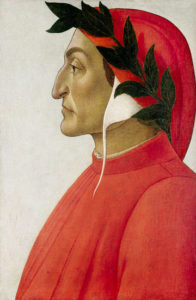 Today is the day we celebrate the birth of Italian poet, prose writer, literary theorist, moral philosopher, and political thinker, Dante, born Durante degli Alighieri in Florence, Italy, in 1265. No one knows for sure the exact date but it is generally believed to be in May. What is known about the poet is that he met his great love and muse, Beatrice, when he was about nine years old; it was love at first sight. Three years later, he was promised in marriage to another girl, but that did not stop him from writin’ about Beatrice in his poetry, where he referred to her as his main reason for livin’. There is a topic that could fill the hours; the main reason for livin’. Right now, my main reason for livin’ is puttin’ words together for you my muse.
Today is the day we celebrate the birth of Italian poet, prose writer, literary theorist, moral philosopher, and political thinker, Dante, born Durante degli Alighieri in Florence, Italy, in 1265. No one knows for sure the exact date but it is generally believed to be in May. What is known about the poet is that he met his great love and muse, Beatrice, when he was about nine years old; it was love at first sight. Three years later, he was promised in marriage to another girl, but that did not stop him from writin’ about Beatrice in his poetry, where he referred to her as his main reason for livin’. There is a topic that could fill the hours; the main reason for livin’. Right now, my main reason for livin’ is puttin’ words together for you my muse.
La Vita Nuova (1293)
- In quella parte del libro de la mia memoria… si trova una rubrica la quale dice: Incipit vita nova.
- In that book which is
My memory…
On the first page
That is the chapter when
I first met you
Appear the words…
Here begins a new life. - Chapter I, opening lines
- In that book which is
- e le braccia avea
madonna involta in un drappo dormendo.
Poi la svegliava, e d’esto core ardendo
lei paventosa umilmente pascea:
appresso gir lo ne vedea piangendo.- In his arms, my lady lay asleep, wrapped in a veil.
He woke her then and trembling and obedient
She ate that burning heart out of his hand;
Weeping I saw him then depart from me. - Chapter I, First Sonnet
- In his arms, my lady lay asleep, wrapped in a veil.
- Ella è quanto de ben pò far natura;
per essemplo di lei bieltà si prova.- She is the sum of nature’s universe.
To her perfection all of beauty tends. - Chapter XIV, lines 49–50
- She is the sum of nature’s universe.
- Amore e ‘l cor gentil sono una cosa…
e così esser l’un sanza l’altro osa
com’alma razional sanza ragione.- Love and the gracious heart are a single thing…
one can no more be without the other
than the reasoning mind without its reason. - Chapter XVI
- Love and the gracious heart are a single thing…
- Sì lungiamente m’ha tenuto Amore
e costumato a la sua segnoria- Love hath so long possessed me for his own
And made his lordship so familiar. - Chapter XXI
- Love hath so long possessed me for his own
-
Il Convivio (1304–1307)
- Amor che ne la mente mi ragiona
de la mia donna disiosamente…
che lo ‘ntelletto sovr’esse disvia.- Love with delight discourses in my mind
Upon my lady’s admirable gifts…
Beyond the range of human intellect. - Trattato Terzo, line 1.
- Love with delight discourses in my mind
- La moralitade è bellezza de la filosofia.
- Morality is the beauty of Philosophy.
- Trattato Terzo, Ch. 15.
- Amor che ne la mente mi ragiona
On this day in 1495 – A monk, John Cor, records the first known batch of Scotch whisky. John Cor is the name of the monk referred to in the first known written reference to a batch of Scotch Whisky.
- “To Brother John Cor, by order of the King, to make aqua vitae VIII bolls of malt.” — Exchequer Rolls 1494–95, Vol x, p. 487.
Brother John Cor was a Tironensian monk based at Lindores Abbey in Fife. He was a servant at the court of James IV. The Tironensians were well regarded for their skills as alchemists. Lindores Abbey is known as the ‘Birthplace of Scotch Whisky’ and visiting there is a pilgrimage for some whisky-lovers. I love a good glass of single malt Scotch, so by all means, raise a glass of cheer to Brother John.
Today is the birthday of Maarten van Heemskerck or Marten Jacobsz Heemskerk van Veen (Heemskerk, Netherlands; 1 June 1498 – 1 October 1574 Haarlem, Netherlands); portrait and religious painter, who spent most of his career in Haarlem. He was a pupil of Jan van Scorel, and adopted his teacher’s Italian-influenced style. He spent the years 1532–6 in Italy. He produced many designs for engravers, and is especially known for his depictions of the Wonders of the World.
Gallery
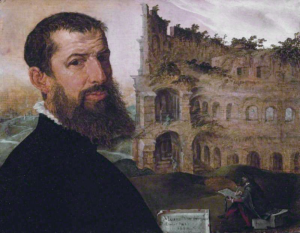
self-portrait with the Colosseum
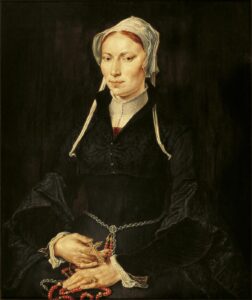
Portrait of an unknown woman
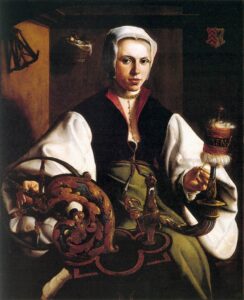
Portrait of a Lady spinning
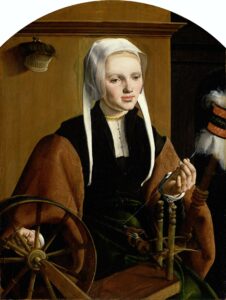
Portrait of a Lady spinning
On this day in 1857 – Charles Baudelaire’s Les Fleurs du mal is published.

The first edition of Les Fleurs du mal with author’s notes.
|
|
Les Fleurs du mal (The Flowers of Evil) is a volume of French poetry by Charles Baudelaire. It was important in the symbolist and modernist movements. The poems deal with themes relating to decadence and eroticism.
- Spleen et Idéal (Spleen and Ideal)
- Tableaux parisiens (Parisian Scenes)
- Le Vin (Wine)
- Fleurs du mal (Flowers of Evil)
- Révolte (Revolt)
- La Mort (Death)
Baudelaire dedicated the book to the poet Théophile Gautier, describing him as a parfait magicien des lettres françaises (“a perfect magician of French letters”).
Foreword
The foreword to the volume, identifying Satan with the pseudonymous alchemist Hermes Trismegistus and calling boredom the worst of miseries, sets the general tone of what is to follow:
Si le viol, le poison, le poignard, l’incendie,
N’ont pas encore brodé de leurs plaisants dessins
Le canevas banal de nos piteux destins,
C’est que notre âme, hélas ! n’est pas assez hardie.If rape, poison, dagger and fire,
Have still not embroidered their pleasant designs
On the banal canvas of our pitiable destinies,
It’s because our soul, alas, is not bold enough!
The preface concludes with the following malediction:
C’est l’Ennui!—l’œil chargé d’un pleur involontaire,
Il rêve d’échafauds en fumant son houka.
Tu le connais, lecteur, ce monstre délicat,
Hypocrite lecteur, — mon semblable, — mon frère !It’s Boredom!—eye brimming with involuntary tears
He dreams of gallows while smoking his hookah.
You know him, reader, this delicate monster,
Hypocritical reader, my likeness, my brother!
| John Masefield | |
|---|---|
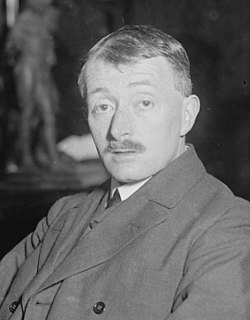
John Masefield in 1916
|
|
Today is the birthday of John Masefield (John Edward Masefield; Ledbury, Herefordshire 1 June 1878 – 12 May 1967 Abingdon, Berkshire); poet, writer, and Poet Laureate of the United Kingdom from 1930 until his death in 1967. Perhaps best remembered as the author of the classic children’s novels The Midnight Folk and The Box of Delights, and poems, including “The Everlasting Mercy” and “Sea-Fever”.
In 1901, when Masefield was 23 he met his future wife, Constance de la Cherois Crommelin (6 February 1867 – 18 February 1960, Rockport, County Antrim, Northern Ireland; a sister to Andrew Claude de la Cherois Crommelin), who was 35 and of Huguenot descent and they married 23 June 1903 St. Mary, Bryanston Square. Educated in classics and English Literature, and a mathematics teacher, Constance was a good match for him, despite the difference in their ages.
Verse
I must down to the seas again, to the lonely sea and the sky,
And all I ask is a tall ship and a star to steer her by,
And the wheel’s kick and the wind’s song and the white sail’s shaking,
And a grey mist on the sea’s face and a grey dawn breaking.
I must down to the seas again, for the call of the running tide
Is a wild call and a clear call that may not be denied;
And all I ask is a windy day with the white clouds flying,
And the flung spray and the blown spume, and the sea-gulls crying.
Most roads lead men homewards, mine leads forth.
I leave you with one of the strongest proclamations of love I have ever heard…
I love him to hell and back and heaven and back, and have and do and will. – Sylvia Plath
thanks for stoppin’ by y’all
Mac Tag
Follow us on twitter @cowboycoleridge

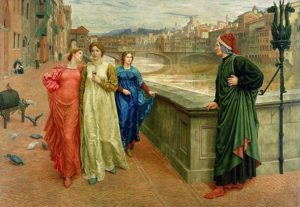
No Comments on "The Lovers’ Chronicle 1 June – reasons – Dante Alighieri – art by Maarten van Heemskerck – Baudelaire’s Les Fleurs du mal – verse by John Masefield"